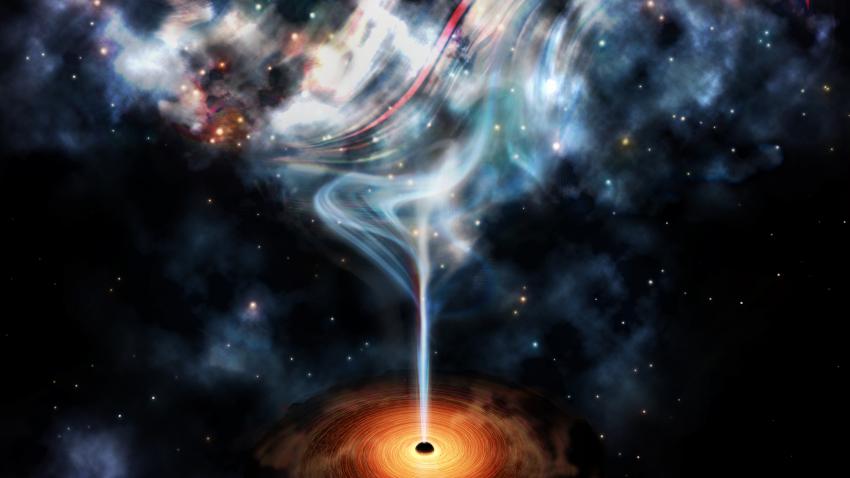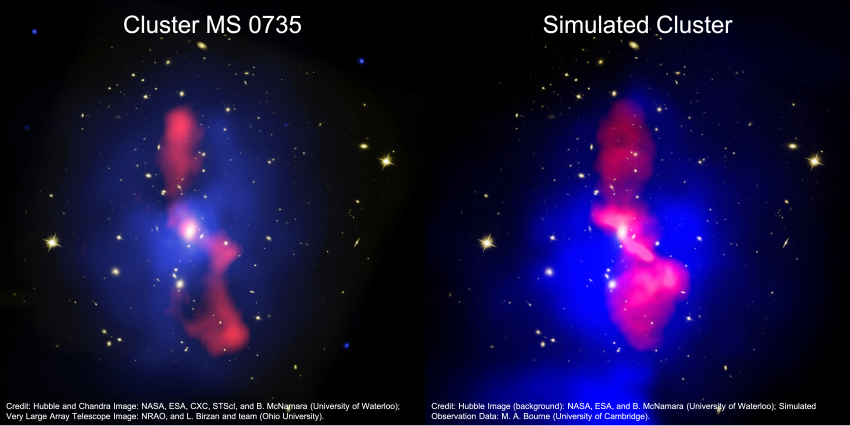“Weather” in clusters of galaxies may explain a longstanding puzzle, according to a team of researchers at the University of Cambridge. The scientists used sophisticated simulations to show how powerful jets from supermassive black holes are disrupted by the motion of hot gas and galaxies, preventing gas from cooling, which could otherwise form stars. The team publish their work in the journal Monthly Notices of the Royal Astronomical Society.
Typical clusters of galaxies have several thousand member galaxies, which can be very different to our own Milky Way and vary in size and shape. These systems are embedded in very hot gas known as the intracluster medium (ICM), all of which live in an unseen halo of so-called ‘dark matter’.
A large number of galaxies have supermassive black holes in their centres, and these often have high speed jets of material stretching over thousands of light years that can inflate very hot lobes in the ICM.
The researchers, based at the Kavli Institute for Cosmology and the Institute of Astronomy, performed state-of-the-art simulations looking at the jet lobes in fine detail and the X-rays emitted as a result. The model captures the birth and cosmological evolution of the galaxy cluster, and allowed the scientists to investigate with unprecedented realism how the jets and lobes they inflate interact with a dynamic ICM.
They found that the mock X-ray observations of the simulated cluster revealed the so-called “X-ray cavities” and “X-ray bright rims” generated by supermassive black hole-driven jets, which itself is distorted by motions in the cluster, remarkably resemble those found in observations of real galaxy clusters.
Dr Martin Bourne of the Institute of Astronomy in Cambridge led the team. He commented: “We have developed new computational techniques, which harness the latest high-performance computing technology, to model for the first time the jet lobes with more than a million elements in fully realistic clusters. This allows us to place the physical processes that drive the liberation of the jet energy under the microscope.”
As galaxies move around in the cluster, the simulation shows they create a kind of ‘weather’, moving, deforming and destroying the hot lobes of gas found at the end of the black hole jets. The jet lobes are enormously powerful and if disrupted, deliver vast amounts of energy to the ICM.
The Cambridge team believe that this cluster weather disruption mechanism may solve an enduring problem: understanding why ICM gas does not cool and form stars in the cluster centre. This so-called “cooling flow” puzzle has plagued astrophysicists for more than 25 years.
The simulations performed provide a tantalising new solution that could solve this problem. Dr Bourne commented: “The combination of the huge energies pumped into the jet lobes by the supermassive black hole and the ability of cluster weather to disrupt the lobes and redistribute this energy to the ICM provides a simple and yet elegant mechanism to solve the cooling flow problem.”
A series of next generation X-ray space telescopes will launch into orbit over the next decade. These advanced instruments should help settle the debate – and if intergalactic weather really does stop the birth of stars.
Media contacts
Dr Robert Massey
Royal Astronomical Society
Tel: +44 (0)20 7292 3979
Mob: +44 (0)7802 877699
press@ras.ac.uk
Science contact
Dr Martin Bourne
Institute of Astronomy
Cambridge
Mob: +44 (0)7557 380858
mabourne@ast.cam.ac.uk
Further information
The new work appears in: “AGN jet feedback on a moving mesh: lobe energetics and X-ray properties in a realistic cluster environment”, M.A. Bourne, D. Sijacki, E. Puchwein, Monthly Notices of the Royal Astronomical Society (2019), 490 (1) (DOI: 10.1093/mnras/stz2604).
The simulations have been performed on the STFC DiRAC HPC facilities which are part of the national e-Infrastructure. The research was funded by European Research Council, STFC and the Kavli Foundation.
Notes for editors
The Royal Astronomical Society (RAS), founded in 1820, encourages and promotes the study of astronomy, solar-system science, geophysics and closely related branches of science. The RAS organises scientific meetings, publishes international research and review journals, recognises outstanding achievements by the award of medals and prizes, maintains an extensive library, supports education through grants and outreach activities and represents UK astronomy nationally and internationally. Its more than 4,400 members (Fellows), a third based overseas, include scientific researchers in universities, observatories and laboratories as well as historians of astronomy and others.
The RAS accepts papers for its journals based on the principle of peer review, in which fellow experts on the editorial boards accept the paper as worth considering. The Society issues press releases based on a similar principle, but the organisations and scientists concerned have overall responsibility for their content.
Follow the RAS on Twitter, Facebook, Instagram and YouTube



